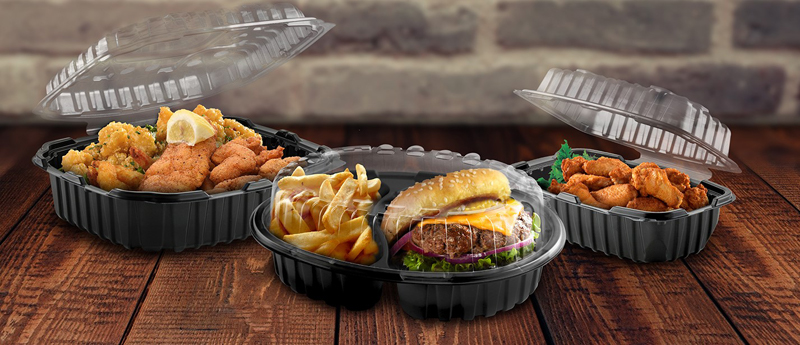For Red Robin, the problem was its seasoned steak fries. As a signature item for the burger brand, it was imperative that the fries, along with the gourmet burgers and growing menu of entrees and sides, hold up in a container for 30 minutes if Red Robin was going to successfully expand its off-premises business.
“We needed ventilation for our steak fries,” says Jason Rusk, VP of business innovation for the Greenwood Village, Colorado-based brand. “At first we basically had a cardboard box.”
A clear lid was another requirement, “so it’s easier for team members to ensure order accuracy,” continued Rusk, who opted to engage Anchor Packaging, a manufacturer already deep into research and development of new products for home delivery.
With a container already on the market designed to keep fried chicken crispy, Anchor undertook “tremendous new product efforts to address a problem at that time that no one felt they could solve: keeping fries crispy,” says Michael Thaler, Anchor’s executive VP of marketing and custom. Anchor adapted its product for fried chicken to develop an entire Crisp Food Technologies line with features such as raised air flow channels on the bottom to promote cross-flow ventilation and clear anti-fog vented dome lids.
Anchor’s R&D department undertook rigorous testing—“We actually used thermal imaging cameras to see exactly what was going on in side that package,” says Thaler—and he even went so far as to place duplicate to-go orders from multiple restaurants, putting one item in Anchor’s packaging to see how the food held up in transport.
“Our goal is to make that experience as great for the consumer as if they were sitting in the restaurant,” says Thaler.
Anchor began its delivery packaging efforts more than two years ago, as some of its chain restaurant customers were early adopters of third-party services and online ordering for pickup. And because “the food in our containers ultimately goes into those delivery bags,” Anchor also aims to educate those companies on its products and how to properly stack containers in the transport bags.
The Crisp Food Technologies products are also all recyclable, Thaler notes, and Anchor is working on tamper-evident packaging.
For its part, Rusk says while Red Robin’s investment in the packaging piece of off-premises operations was significant, “You don’t need a server, you don’t need a dishwasher for those orders,” so there are some associated cost savings.
When considering the entire restaurant delivery cost equation, much of the focus gets put on the 25 percent to 30 percent that the third-party services take from each order, points out Thaler, but packaging, “the right packaging, is usually 3 percent or less of the check amount.” It’s worth investing in, he continues, because the consumer “almost always” blames the restaurant if their food arrives in poor condition.
“Packaging does play a key role in ensuring your brand is presented in the way you want it to be,” says Rusk. “And third-party or off-premises in general, it’s only going to grow.”
Other food packaging manufacturers such as Genpak are developing or expanding on their lines of delivery and takeout containers. And Sheboygan, Wisconsin-based Vollrath Company just came out with a full line of food delivery and transport bags it says extend the delivery range for restaurants. In the 3-Series, for example, hot food generates heat in the bag while the insulation helps retain the heat to keep food warm. The 5-Series features a heat pad that preheats the bag and is either unplugged for transport or powered by an optional 12-volt in-car power cord.
Another consideration for restaurants: When moving to new packaging, especially if there are multiple locations such as in a franchise or chain operation, executives need to understand the rollout could take several months. Chick-fil-A took three months to change over, Thaler says, because operators didn’t want to throw away the containers they already had.


